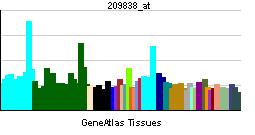COPS2
| COP9 constitutive photomorphogenic homolog subunit 2 (Arabidopsis) | |||||||||||
|---|---|---|---|---|---|---|---|---|---|---|---|
| Identifiers | |||||||||||
| Symbols | COPS2 ; CSN2; ALIEN; SGN2; TRIP15 | ||||||||||
| External IDs | Template:OMIM5 Template:MGI HomoloGene: 3124 | ||||||||||
| |||||||||||
| RNA expression pattern | |||||||||||
 | |||||||||||
 | |||||||||||
| More reference expression data | |||||||||||
| Orthologs | |||||||||||
| Template:GNF Ortholog box | |||||||||||
| Species | Human | Mouse | |||||||||
| Entrez | n/a | n/a | |||||||||
| Ensembl | n/a | n/a | |||||||||
| UniProt | n/a | n/a | |||||||||
| RefSeq (mRNA) | n/a | n/a | |||||||||
| RefSeq (protein) | n/a | n/a | |||||||||
| Location (UCSC) | n/a | n/a | |||||||||
| PubMed search | n/a | n/a | |||||||||
COP9 constitutive photomorphogenic homolog subunit 2 (Arabidopsis), also known as COPS2, is a human gene.[1]
References
Further reading
- Wolf DA, Zhou C, Wee S (2004). "The COP9 signalosome: an assembly and maintenance platform for cullin ubiquitin ligases?". Nat. Cell Biol. 5 (12): 1029–33. doi:10.1038/ncb1203-1029. PMID 14647295.
- Lee JW, Choi HS, Gyuris J; et al. (1995). "Two classes of proteins dependent on either the presence or absence of thyroid hormone for interaction with the thyroid hormone receptor". Mol. Endocrinol. 9 (2): 243–54. PMID 7776974.
- Maruyama K, Sugano S (1994). "Oligo-capping: a simple method to replace the cap structure of eukaryotic mRNAs with oligoribonucleotides". Gene. 138 (1–2): 171–4. PMID 8125298.
- Suzuki Y, Yoshitomo-Nakagawa K, Maruyama K; et al. (1997). "Construction and characterization of a full length-enriched and a 5'-end-enriched cDNA library". Gene. 200 (1–2): 149–56. PMID 9373149.
- Seeger M, Kraft R, Ferrell K; et al. (1998). "A novel protein complex involved in signal transduction possessing similarities to 26S proteasome subunits". FASEB J. 12 (6): 469–78. PMID 9535219.
- Wei N, Tsuge T, Serino G; et al. (1998). "The COP9 complex is conserved between plants and mammals and is related to the 26S proteasome regulatory complex". Curr. Biol. 8 (16): 919–22. PMID 9707402.
- Schaefer L, Beermann ML, Miller JB (1999). "Coding sequence, genomic organization, chromosomal localization, and expression pattern of the signalosome component Cops2: the mouse homologue of Drosophila alien". Genomics. 56 (3): 310–6. doi:10.1006/geno.1998.5728. PMID 10087198.
- Dressel U, Thormeyer D, Altincicek B; et al. (1999). "Alien, a highly conserved protein with characteristics of a corepressor for members of the nuclear hormone receptor superfamily". Mol. Cell. Biol. 19 (5): 3383–94. PMID 10207062.
- Naumann M, Bech-Otschir D, Huang X; et al. (2000). "COP9 signalosome-directed c-Jun activation/stabilization is independent of JNK". J. Biol. Chem. 274 (50): 35297–300. PMID 10585392.
- Altincicek B, Tenbaum SP, Dressel U; et al. (2000). "Interaction of the corepressor Alien with DAX-1 is abrogated by mutations of DAX-1 involved in adrenal hypoplasia congenita". J. Biol. Chem. 275 (11): 7662–7. PMID 10713076.
- Hu RM, Han ZG, Song HD; et al. (2000). "Gene expression profiling in the human hypothalamus-pituitary-adrenal axis and full-length cDNA cloning". Proc. Natl. Acad. Sci. U.S.A. 97 (17): 9543–8. doi:10.1073/pnas.160270997. PMID 10931946.
- Cohen H, Azriel A, Cohen T; et al. (2001). "Interaction between interferon consensus sequence-binding protein and COP9/signalosome subunit CSN2 (Trip15). A possible link between interferon regulatory factor signaling and the COP9/signalosome". J. Biol. Chem. 275 (50): 39081–9. doi:10.1074/jbc.M004900200. PMID 10991940.
- Tsuge T, Matsui M, Wei N (2001). "The subunit 1 of the COP9 signalosome suppresses gene expression through its N-terminal domain and incorporates into the complex through the PCI domain". J. Mol. Biol. 305 (1): 1–9. doi:10.1006/jmbi.2000.4288. PMID 11114242.
- Bech-Otschir D, Kraft R, Huang X; et al. (2001). "COP9 signalosome-specific phosphorylation targets p53 to degradation by the ubiquitin system". EMBO J. 20 (7): 1630–9. doi:10.1093/emboj/20.7.1630. PMID 11285227.
- Lyapina S, Cope G, Shevchenko A; et al. (2001). "Promotion of NEDD-CUL1 conjugate cleavage by COP9 signalosome". Science. 292 (5520): 1382–5. doi:10.1126/science.1059780. PMID 11337588.
- Hoareau Alves K, Bochard V, Réty S, Jalinot P (2002). "Association of the mammalian proto-oncoprotein Int-6 with the three protein complexes eIF3, COP9 signalosome and 26S proteasome". FEBS Lett. 527 (1–3): 15–21. PMID 12220626.
- Strausberg RL, Feingold EA, Grouse LH; et al. (2003). "Generation and initial analysis of more than 15,000 full-length human and mouse cDNA sequences". Proc. Natl. Acad. Sci. U.S.A. 99 (26): 16899–903. doi:10.1073/pnas.242603899. PMID 12477932.
- Akiyama H, Fujisawa N, Tashiro Y; et al. (2003). "The role of transcriptional corepressor Nif3l1 in early stage of neural differentiation via cooperation with Trip15/CSN2". J. Biol. Chem. 278 (12): 10752–62. doi:10.1074/jbc.M209856200. PMID 12522100.
- Serino G, Su H, Peng Z; et al. (2003). "Characterization of the last subunit of the Arabidopsis COP9 signalosome: implications for the overall structure and origin of the complex". Plant Cell. 15 (3): 719–31. PMID 12615944.
- Uhle S, Medalia O, Waldron R; et al. (2003). "Protein kinase CK2 and protein kinase D are associated with the COP9 signalosome". EMBO J. 22 (6): 1302–12. doi:10.1093/emboj/cdg127. PMID 12628923.
| This protein-related article is a stub. You can help Wikipedia by expanding it. |